SLIPPED upper femoral epiphysis (SUFE) is a condition which occurs in 1-7 individuals per 100,000 and, as such, is likely to be encountered once or twice in any one general practitioner’s career. A recent study has identified a 2.5 fold increase in the incidence of SUFE and has suggested a link with the growing problem of childhood obesity.
Unfortunately, in a proportion of cases, delay in diagnosis in primary care has a devastating effect on the outcome – a disabled adolescent being the end result. Despite many previous studies drawing attention to this problem, SUFE persists as a regular source of medicolegal claims, often in excess of £100,000.
SUFE occurs typically in the age group of 10-16, and boys are affected twice as commonly as girls. However, there has been an increase in children as young as 8 years presenting with SUFE, and when it occurs in this age group bilateral disease is more common. Whilst the classic body habitus is an obese “hypogonadic” child, it may also occur in tall thin individuals.
Certain conditions are associated with increased risk of SUFE in children:
previous slip on the other side (30 per cent of slips are bilateral, half of which present simultaneously, the other half sequentially)
- hypothyroidism
- hypogonadism
- panhypopituitarism
- primary and secondary hyperparathyroidism
- growth hormone deficiency
- children on steroids
- children on chemotherapy and/or radiotherapy.
History and examination
The history is often misleading. Usually the onset of symptoms is insidious, with imprecise recall for timing. Frequently, symptoms follow sport and are attributed to muscular strain. Traditionally, three weeks has been the watershed between a slip being regarded as acute or chronic. This is somewhat artificial and is unhelpful in assessing outcome.
Most patients will have hip or groin pain, often referred to the knee. Isolated knee or distal thigh pain occurs in approximately 20 per cent of cases, with no suggestion of hip or groin pain, and it is these cases who are particularly at risk of misdiagnosis and subsequent delay to referral. The presence of a limp should be noted and whether it is painful. Pain on weight bearing is an important symptom.
It is often forgotten that SUFE is a condition that progresses and any increase in the severity of symptoms or signs is very important to recognise. In 10 per cent of cases, inability to weight bear with crutches may develop – this is the definition of an unstable slip in which rapid and severe displacement can occur spontaneously or precipitated by minimal trauma such as a stumble.
A careful examination is essential. Adolescent knee conditions such as Osgood–Schlatter’s or chondromalacia patellae are common in this age group; however, knee pain in the presence of a normal knee examination should be regarded as SUFE until proven otherwise.
Hip examination has been reported as being abnormal in 90 per cent of cases of SUFE. Pain on passive hip movement is highly significant; however, SUFE can be “silent” and painless with deformity developing slowly over months. Such cases are identified by looking for asymmetry of limb rotation as demonstrated by:
- unilateral out-toeing on walking
- one foot pointing outwards when lying supine
- automatically moving into external rotation when the hip is flexed, or reduced internal hip rotation on prone examination.
Early diagnosis essential
With time, the angulation between the epiphysis and femoral neck increases. In most cases the patient is able to weight bear (a stable slip). Early diagnosis before the slip has progressed enables surgical stabilisation with a single percutaneous screw – an uncomplicated procedure with the expectation of a near to normal outcome.
With increasing displacement, the function of the hip is compromised to the extent that corrective osteotomy may become necessary to enable the patient to walk effectively. The outcome of such surgery is unpredictable and premature degenerative arthritis in the third or fourth decade not uncommon. Avascular necrosis develops in approximately 10 to 15 per cent of patients undergoing corrective osteotomy and may be associated with hip replacement or arthrodesis in the second or third decade. Avascular necrosis can occur in up to 50 per cent of cases if the slip becomes unstable. Instability occurs in 5-10 per cent of all cases of SUFE.
Medicolegal aspects
Individual cases make sad reading, with major impacts on patients’ lives and, indeed, attitudes to life and work. The loss of earning potential in patients unable to pursue intended careers accounts for those cases which settle for over £100,000, whilst those involving pain and suffering, cosmetic problems and increased risk of osteoarthritis settle in the £10,000-£60,000 range. The legal costs associated with these cases tend to be high because of their complexity. Cases can also take 3-5 years to resolve, and this is another factor that young adults find difficult to come to terms with.
Common pitfalls leading to claims include:
- Failure to consider the diagnosis, particularly when knee pain is the presenting symptom.
- Failure to exam the hip and record the findings.
- Incorrectly being reassured by a previous “normal” X-ray report, and failing to appreciate that SUFE is a condition that evolves.
- Delay to referral often for administrative reasons despite considering the diagnosis.
- Lack of appreciation of the relevance of difficulty with weight bearing, the concept of instability and the urgency of referral.
Minimising the risk
Hip, groin, distal thigh or knee pain in this age group should always be regarded as a potential SUFE. If the hip examination is normal it should be recorded, and review in the surgery is appropriate. Referral should be considered if symptoms persist without improvement beyond a week.
Deterioration in symptoms and/or the presence of abnormal hip examination are indications for early specialist review and should be discussed with the local orthopaedic service to agree timing of appointment.
A sudden increase in the severity of pain or difficulty in weight bearing should be regarded as an indication for immediate referral to hospital, avoiding movement of the affected hip and preventing attempts at weight bearing. Surgical treatment of such cases within 24 hours of onset of symptoms is associated with a lower rate of complications.
Mr Jamie MacLean is Lead Consultant at Tayside Childrens Orthopaedic Service and also provides expert reports for the MDDUS

This page was correct at the time of publication. Any guidance is intended as general guidance for members only. If you are a member and need specific advice relating to your own circumstances, please contact one of our advisers.
Read more from this issue of Insight

Save this article
Save this article to a list of favourite articles which members can access in their account.
Save to library
